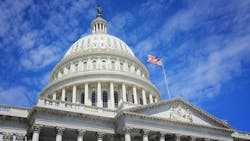Key takeaways for public transit, passenger rail funding from House Appropriations FY 2026 THUD Appropriations Bill
The House Appropriations Transportation, Housing and Urban Development (THUD), and Related Agencies Subcommittee met July 14 to complete its initial markup of its THUD Appropriations fiscal year (FY) 2026 bill. Following the meeting, the measure was approved by the subcommittee.
The THUD Appropriations Bill provides a total discretionary allocation of $89.9 billion, $4.5 billion, or 4.7 percent, below the FY25 enacted level. The subcommittee says this level reflects the “America First” agenda by including responsible levels for housing programs and reprioritizing transportation funding to meet infrastructure needs across the U.S. The subcommittee notes it prioritized investments in air traffic control infrastructure, controller hiring and transportation safety while maintaining essential housing assistance.
"The bill prioritizes transportation safety—on our railways, roads and airways—and ensures a responsible safety net with housing support for our most vulnerable citizens, especially the elderly, the disabled, veterans and the working poor,” said THUD Subcommittee Chairman Steve Womack (R-AR-3). “We have eliminated or reduced 38 programs, totaling $7.3 billion in savings. Additionally, we are redirecting over $4 billion from programs funded through the Infrastructure Investment and Jobs Act (IIJA) to real infrastructure: air traffic control, highways, maritime and rail.”
However, a legislative update issued by the American Public Transportation Association (APTA) identified “significant” funding cuts for transit and passenger rail compared to the levels from the IIJA. In this appropriations bill, combined with the IIJA’s advance appropriations, $19.2 billion will be allocated to public transit in FY26, an 8.3 percent decrease compared to the FY25 enacted level. APTA highlights that this includes cutting nearly all General Fund appropriations for the Capital Investment Grants (CIG) program, resulting in about 14 percent less than the amount authorized in the IIJA.
The THUD FY26 Appropriations Bill also has a handful of policy riders, some of which prohibit the use of funds that contradict current executive orders, including ones related to diversity, equity and inclusion, regulatory streamlining and English proficiency.
Additional Resources
- FY26 THUD Appropriations Bill key takeaways released by the subcommittee
- APTA's legislative updates highlighting impacts to public transit and passenger rail
- APTA's CIG Project Pipeline Dashboard
- APTA's Public Transit Funding by Program Table of the THUD bill
- APTA's Passenger Rail Funding by Program Table of the THUD bill
Public transit sees over eight percent reduction in funding
The total funding for public transit for FY26 is $3.1 billion, or 13.9 percent less than the funding level authorized in the IIJA. However, it does fully fund the public transit contract authority at $14.64 billion, as provided in the IIJA. This is a $363 million increase compared to the FY25 enacted levels, according to APTA’s legislative update.
Perhaps most significant are the cuts in total CIG funding, as communities are currently requesting $36 billion in CIG funding for FY26 and beyond. Right now, the appropriations bill cuts program funding by $2.2 billion, or a nearly 57 percent decrease from the FY25 levels. APTA’s update notes the bill provides $54 million in General Fund appropriations for CIG funding, a nearly 98 percent cut. Of the $1.6 billion in advance appropriations, APTA notes that $404 million is available for new fixed guideway projects and $1.2 billion for Small Starts.
This THUD Appropriations Bill does not increase funding levels above what was authorized by the IIJA for the Buses and Bus Facilities, Competitive Grants, Low-No Emission Bus Competitive Grants or Ferry Grants. There is $96 million set aside for congressionally directed spending, or earmarks, for specific transit projects.
One of the policy provisions affecting public transit includes a section blocking the Rostenkowski Test, which prevents a potential complete cut of FY26 transit formula funds for individual agencies. The bill, however, does not block the U.S. Department of Transportation (USDOT) “from impeding or hindering a project from advancing or approving a project seeking a CIG Federal share of more than 40 percent,” according to APTA’s update.
Passenger and freight rail gets a nearly 16 percent funding cut
A total of $13.6 billion is included for passenger and freight rail, resulting in a $2.6 billion or nearly 16 percent funding cat from FY25 levels. Compared to the amount authorized by the IIJA, the total funding is $7.4 billion, or 35 percent less.
In the bill, $2.3 billion is set aside for Amtrak grants, including $1.4 billion for the national network and $924 million for the Northeast Corridor. However, the General Fund appropriation reserved for Amtrak saw a decrease of $115 million, or about five percent. One of the few grant programs with an increase of funding is the Consolidated Rail Infrastructure Safety Improvement (CRISI) grant program. This bill would provide $538 million, an increase of $438 million from the FY25 levels. It also includes $38.4 million in CRISI grants for congressionally directed spending for designated CRISI projects.
APTA notes this funding comes from transferring $2.8 in unobligated FY26 funding from the Federal-State Partnership for Intercity Passenger Rail Program, which was originally offered through advanced appropriations in the IIJA. Because of this, this program will have $4.4 billion available in funding for FY26.
Notably, sections of the bill block any funding for the California High-Speed Rail project, Texas Central Railway project and Northern Lights Express Intercity Passenger Rail project.
USDOT programs see slash in funding
According to a brief released by the subcommittee, the bill does not include additional appropriations for the Rebuilding American Infrastructure with Sustainability and Equity (RAISE) or National Infrastructure Project Assistance (Mega) grant programs, noting these receive a collective $2.5 billion in advanced appropriations for FY25 through the IIJA. APTA also points out that the bill doesn’t offer General Fund appropriation for the Better Utilizing Investments to Leverage Development program.
Another section of the bill also prohibits the USDOT from enforcing mask mandates to prevent the spread of COVID-19.
About the Author
Megan Perrero
Editor in Chief
Megan Perrero is a national award-winning B2B journalist and lover of all things transit. Currently, she is the Editor in Chief of Mass Transit magazine, where she develops and leads a multi-channel editorial strategy while reporting on the North American public transit industry.
Prior to her position with Mass Transit, Perrero was the senior communications and external relations specialist for the Shared-Use Mobility Center, where she was responsible for helping develop internal/external communications, plan the National Shared Mobility Summit and manage brand strategy and marketing campaigns.
Perrero serves as the board secretary for Latinos In Transit and is a member of the American Public Transportation Association Marketing and Communications Committee. She holds a bachelor’s degree in multimedia journalism with a concentration in magazine writing and a minor in public relations from Columbia College Chicago.

